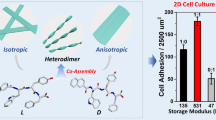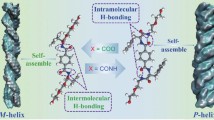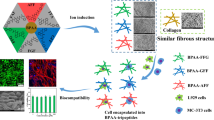Abstract
Fluorine atoms confer desirable biophysical, chemical, and biological properties to peptides/proteins by participating in various intermolecular interactions with their environment, but they are rarely used to control supramolecular chirality and functional. Herein, to identify the effects of fluorine substitution on the chirality and function of supramolecular assemblies, C2-symmetric benzene-paradicarboxamide-based phenylalanine (phe) derivatives and three monofluorinated variants that had a single fluorine atom on their benzyl side chain in either the ortho, meta, or para position were synthesized. The experimental and theoretical results clearly show that the resulting assembled fibrils were supported by multiple interactions, including hydrogen bonding, π–π stacking and C/O–H···F–CAr interactions. Compared to nonfluorinated analogs, fluorine and its ring position on the aromatic side chain dictated the type and strength of the F···H interaction and then induced changes in supramolecular chirality and fiber morphology. Further studies on cell behavior showed that the order of positive interaction between high-order supramolecular chirality (M, P) and molecular chirality (L, D) on cell proliferation and viability is LM > DM > LP > DP. These findings provide a protocol for leveraging fluorine atoms and their positional dependence on directing chiral nanostructures with desirable handedness and creating fluorinated supramolecular hydrogels as extracellular matrix-mimetic scaffolds for cell culture and regenerative medicine.
Graphical Abstract

The helical chirality can be reversed by introducing a fluorine atom into the supramolecular system and changing its ring position on the aromatic side chain, which are attributed to fluorous interactions dictate the helical orientation and morphology of supramolecular assemblies.





Similar content being viewed by others
References
Collier JH, Rudra JS, Gasiorowski JZ, Jung JP. Multi-component extracellular matrices based on peptide self-assembly. Chem Soc Rev 2010;39:3413.
Sinden RR. Molecular biology: DNA twists and flips. Nature 2005;437:1097.
Ghosh A, Bansal M. A glossary of DNA structures from A to Z. Acta Crystallogr D 2003;59:620.
Das RK, Zouani OF, Labrugere C, Oda R, Durrieu MC. Influence of nanohelical shape and periodicity on stem cell fate. ACS Nano 2013;7:3351.
Fishwick CWG, Beevers AJ, Carrick LM, Whitehouse CD, Aggeli A, Boden N. Structures of Helical β-tapes and twisted ribbons: the role of side-chain interactions on twist and bend behavior. Nano Lett 2003;3:1475.
Castelletto V, Hamley IW, Hule RA, Pochan D. Helical-Ribbon formation by a β-amino acid modified amyloid β-peptide fragment. Angew Chem Int Ed 2009;48:2317.
Walters RF, DeGrado WF. Helix-packing motifs in membrane proteins. Proc Natl Acad Sci USA 2006;103:13658.
Lv K, Zhang L, Lu W, Liu M. Control of supramolecular chirality of nanofibers and its effect on protein adhesion. ACS Appl Mater Interfaces 2014;6:18878.
Miao W, Yang D, Liu M. Multiple-stimulus-responsive supramolecular gels and regulation of chiral twists: the effect of spacer length. Chem Eur J 2015;21:7562.
**ng Q, Zhang J, **e Y, Wang Y, Qi W, Rao H, Su R, He Z. Aromatic motifs dictate nanohelix handedness of tripeptides. ACS Nano 2018;12:12305.
Liu J, Zhao Y, Zhao C, Dou X, Ma X, Guan S, Jia Y, Feng C. Hydrogen-bonding regulated supramolecular chirality with controllable biostability. Nano Res 2022;15:2226.
Travers A, Muskhelishvili G. DNA structure and function. FEBS J 2015;282:2279.
Dou X, Mehwish N, Zhao C, Liu J, **ng C, Feng C. Supramolecular hydrogels with tunable chirality for promising biomedical applications. Acc Chem Res 2020;53:852.
Yashima E, Maeda K, Iida H, Furusho Y, Nagai K. Helical polymers: synthesis, structures, and functions. Chem Rev 2009;109:6102.
Deming TJ, Klok HA, Armes SP, Becker ML, Champion JA, Chen EY, Heilshorn SC, van Hest JCM, Irvine DJ, Johnson JA, Kiessling LL, Maynard HD, de la Cruz MO, Sullivan MO, Tirrell MV, Anseth KS, Lecommandoux S, Percec S, Zhong Z, Albertsson AC. Polymers at the interface with biology. Biomacromol 2018;19:3151.
Ren Z, Gao PX. A review of helical nanostructures: growth theories, synthesis strategies and properties. Nanoscale 2014;6:9366.
Peng T, Dang-i AY, Liu J, Feng C. [2 + 2] photocycloaddition reaction regulated the stability and morphology of hydrogels. Adv Fiber Mater 2019;1:241.
Yan X, Weng P, Shi D, Jiang YB. Supramolecular helices from helical building blocks via head-to-tail intermolecular interactions. Chem Commun 2021;57:12562.
Lehn J-M. Toward self-organization and complex matter. Science 2002;295:2400.
Leigh T, Fernandez-Trillo P. Helical polymers for biological and medical applications. Nat Rev Chem 2020;4:291.
Du X, Zhou J, Shi J, Xu B. Supramolecular hydrogelators and hydrogels: from soft matter to molecular biomaterials. Chem Rev 2015;115:13165.
Deng M, Zhang L, Jiang Y, Liu M. Role of achiral nucleobases in multicomponent chiral self-assembly: purine-triggered helix and chirality transfer. Angew Chem Int Ed 2016;55:15062.
Lv Z, Chen Z, Shao K, Qing G, Sun T. Stimuli-directed helical chirality inversion and bio-applications. Polymers 2016;8:310.
Hendrikse SIS, Contreras-Montoya R, Ellis AV, Thordarson P, Steed JW. Biofunctionality with a twist: the importance of molecular organisation, handedness and configuration in synthetic biomaterial design. Chem Soc Rev 2022;51:28.
Zhou J, Li J, Du X, Xu B. Supramolecular biofunctional materials. Biomaterials 2017;129:1.
Yashima E, Ousaka N, Taura D, Shimomura K, Ikai T, Maeda K. Supramolecular helical systems: helical assemblies of small molecules, foldamers, and polymers with chiral amplification and their functions. Chem Rev 2016;116:13752.
Mehwish N, Dou X, Zhao C, Feng C, Fu Q. Chirality transfer in supramolecular co-assembled fibrous material enabling the visual recognition of sucrose. Adv Fiber Mater 2020;2:204.
Yang L, Tan X, Wang Z, Zhang X. Supramolecular polymers: historical development, preparation, characterization, and functions. Chem Rev 2015;115:7196.
Liu M, Zhang L, Wang T. Supramolecular chirality in self-assembled systems. Chem Rev 2015;115:7304.
Zhang YS, Khademhosseini A. Advances in engineering hydrogels. Science 2017;356:500.
Huang H, Orlova T, Matt B, Katsonis N. Long-lived supramolecular helices promoted by fluorinated photoswitches. Macromol Rapid Commun 2018;39:1700387.
Berger R, Resnati G, Metrangolo P, Weber E, Hulliger J. Organic fluorine compounds: a great opportunity for enhanced materials properties. Chem Soc Rev 2011;40:3496.
Sloand JN, Miller MA, Medina SH. Fluorinated peptide biomaterials. Pept Sci 2021;113:e24184.
Salwiczek M, Nyakatura EK, Gerling UI, Ye S, Koksch B. Fluorinated amino acids: compatibility with native protein structures and effects on protein-protein interactions. Chem Soc Rev 2012;41:2135.
Aviv M, Cohen-Gerassi D, Orr AA, Misra R, Arnon ZA, Shimon LJW, Shacham-Diamand Y, Tamamis P, Adler-Abramovich L. Modification of a single atom affects the physical properties of double fluorinated Fmoc-Phe derivatives. Int J Mol Sci 2021;22:9634.
Berger AA, Voller JS, Budisa N, Koksch B. Deciphering the fluorine code-the many hats fluorine wears in a protein environment. Acc Chem Res 2017;50:2093.
Kaur G, Panini P, Chopra D, Roy CA. Structural investigation of weak intermolecular interactions in fluorine substituted isomeric N-Benzylideneanilines. Cryst Growth Des 2012;12:5096.
O’Hagan D. Understanding organofluorine chemistry. An introduction to the C-F bond. Chem Soc Rev 2008;37:308.
Biffinger JC, Kim HW, DiMagno SG. The polar hydrophobicity of fluorinated compounds. ChemBioChem 2004;5:622.
Kumar S, Kaul I, Biswas P, Das A. Structure of 7-azaindole…2-fluoropyridine dimer in a supersonic jet: competition between N-H···N and N-H···F interactions. J Phys Chem A 2011;115:10299.
Struble MD, Strull J, Patel K, Siegler MA, Lectka T. Modulating, “jousting” C-F···H-C interactions with a bit of hydrogen bonding. J Org Chem 2014;79:1.
Shang J, Gallagher NM, Bie F, Li Q, Che Y, Wang Y, Jiang H. Aromatic triazole foldamers induced by C-H···X (X = F, Cl) intramolecular hydrogen bonding. J Org Chem 2014;79:5134.
Reichenbacher K, Suss HI, Hulliger J. Fluorine in crystal engineering–"the little atom that could". Chem Soc Rev 2005;34:22.
Kralj S, Bellotto O, Parisi E, Garcia AM, Iglesias D, Semeraro S, Deganutti C, D’Andrea P, Vargiu AV, Geremia S, De Zorzi R, Marchesan S. Heterochirality and halogenation control Phe-Phe hierarchical assembly. ACS Nano 2020;14:16951.
Quigley E, Johnson J, Liyanage W, Nilsson BL. Impact of gelation method on thixotropic properties of phenylalanine-derived supramolecular hydrogels. Soft Matter 2020;16:10158.
Ryan DM, Anderson SB, Nilsson BL. The influence of side-chain halogenation on the self-assembly and hydrogelation of Fmoc-phenylalanine derivatives. Soft Matter 2010;6:3220.
Zong Z, Hao A, **ng P. Halogenation regulates supramolecular chirality at hierarchical levels of self-assembled N-terminal aromatic amino acids. J Phys Chem Lett 2021;12:1307.
Xu Y, Hao A, **ng P. X···X halogen bond-induced supramolecular helices. Angew Chem Int Ed 2022;61:e202113786.
Wang Z, Hao A, **ng P. Chiroptical helices of N-terminal aryl amino acids through orthogonal noncovalent interactions. Angew Chem Int Ed 2020;59:11556.
An S, Hao A, **ng P. Polyhedral oligosilsesquioxanes in functional chiral nanoassemblies. Angew Chem Int Ed 2021;60:9902.
Grimme S, Ehrlich S, Goerigk L. Effect of the dam** function in dispersion corrected density functional theory. J Comput Chem 2011;32:1456.
Lu T, Chen F. Multiwfn: a multifunctional wavefunction analyzer. J Comput Chem 2012;33:580.
Jiang S, Zeng Q, Zhao K, Liu J, Sun Q, Huang K, He Y, Zhang X, Wang H, Shi X, Feng C, Deng X, Wei Y. Chirality bias tissue homeostasis by manipulating immunological response. Adv Mater 2022;34:e2105136.
Liu J, Yuan F, Ma X, Auphedeous DY, Zhao C, Liu C, Shen C, Feng C. The cooperative effect of both molecular and supramolecular chirality on cell adhesion. Angew Chem Int Ed 2018;57:6475.
Liu G, Sheng J, Wu H, Yang C, Yang G, Li Y, Ganguly R, Zhu L, Zhao Y. Controlling supramolecular chirality of two-component hydrogels by J- and H-aggregation of building blocks. J Am Chem Soc 2018;140:6467.
Ogi S, Sugiyasu K, Manna S, Samitsu S, Takeuchi M. Living supramolecular polymerization realized through a biomimetic approach. Nat Chem 2014;6:188.
Mabesoone MFJ, Markvoort AJ, Banno M, Yamaguchi T, Helmich F, Naito Y, Yashima E, Palmans ARA, Meijer EW. Competing interactions in hierarchical porphyrin self-assembly introduce robustness in pathway complexity. J Am Chem Soc 2018;140:7810.
Maity S, Das P, Reches M. Inversion of supramolecular chirality by sonication-induced organogelation. Sci Rep 2015;5:16365.
Arokianathan JF, Ramya KA, Janeena A, Deshpande AP, Ayyadurai N, Leemarose A, Shanmugam G. Non-proteinogenic amino acid based supramolecular hydrogel material for enhanced cell proliferation. Colloids Surf B 2020;185:110581.
Siemsen K, Rajput S, Rasch F, Taheri F, Adelung R, Lammerding J, Selhuber-Unkel C. Tunable 3D hydrogel microchannel networks to study confined mammalian cell migration. Adv Healthcare Mater 2021;10:e2100625.
Motealleh A, Seda KN. Janus nanocomposite hydrogels for chirality-dependent cell adhesion and migration. ACS Appl Mater Interfaces 2017;9:33674.
Dou X, Wu B, Liu J, Zhao C, Qin M, Wang Z, Schonherr H, Feng C. Effect of chirality on cell spreading and differentiation: from chiral molecules to chiral self-assembly. ACS Appl Mater Interfaces 2019;11:38568.
Acknowledgements
H. J. Lu and Y. Zhao contributed equally to this work. This work was supported by the National Natural Science Foundation of China (Nos. 52003072, 51833006), Chinese Postdoctoral Science Foundation (2021M690891), the GHfund B (20220202, ghfund202202021124), Key Scientific and Technological Project of Henan Province 222102310494, and Startup Fund for Young Faculty at SJTU.
Author information
Authors and Affiliations
Corresponding authors
Ethics declarations
Conflict of Interest
The authors declare no competing financial interests.
Additional information
Publisher's Note
Springer Nature remains neutral with regard to jurisdictional claims in published maps and institutional affiliations.
Supplementary Information
Below is the link to the electronic supplementary material.
Rights and permissions
Springer Nature or its licensor (e.g. a society or other partner) holds exclusive rights to this article under a publishing agreement with the author(s) or other rightsholder(s); author self-archiving of the accepted manuscript version of this article is solely governed by the terms of such publishing agreement and applicable law.
About this article
Cite this article
Lu, H., Zhao, Y., Qin, S. et al. Fluorine Substitution Tunes the Nanofiber Chirality of Supramolecular Hydrogels to Promote Cell Adhesion and Proliferation. Adv. Fiber Mater. 5, 377–387 (2023). https://doi.org/10.1007/s42765-022-00232-w
Received:
Accepted:
Published:
Issue Date:
DOI: https://doi.org/10.1007/s42765-022-00232-w




